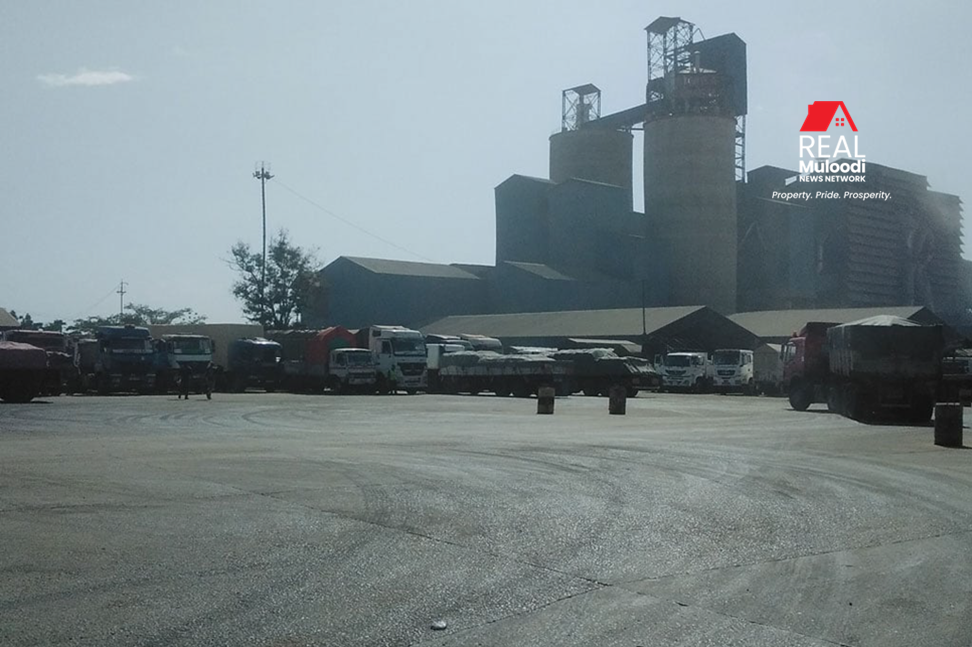UGANDA, Tororo | Real Muloodi News | Cement prices have risen sharply in the last two weeks as a result of power outages that have hampered the output of cement in numerous firms since the beginning of January
Two weeks ago, a bag of cement cost USh32,000 in Kampala and Wakiso districts; currently, it costs between USh37,000 and USh40,000, an increase of nearly USh8,000, negatively impacting the construction industry.
Various cement manufacturers around the country have blamed the hike in cement prices on the country’s erratic power supply, which they say has hampered production levels, requiring them to purchase diesel to power their equipment and raising the final cost of cement.
Three cement factories, including Tororo, Simba, and Hima, are found in the Tororo District.
Tororo Cement
According to the officials of the Tororo Cement factory, one of the country’s biggest cement manufacturers, the factory has registered a 50% decrease in production, which used to stand at 1.2 million tonnes annually.
Mr Darmandra Pratap Singh, Manager of Instrumentation at Tororo Cement, stated that the problem began on January 5 when power transmission was disrupted for five days.
“They claimed some of the transformers at Tororo main substation had developed technical glitches that required an overhaul but since then, the amount of power has remained insufficient and unstable. We have failed to resume to full capacity production,” he said.
He stated that while power fluctuations have been a burden for them as manufacturers for many years, the recent unpredictable supply has caused more harm to their installations and production than ever before.
“If this crisis persists, it will likely attract an increase in prices since the demand may overwhelm production,” he said.
Tororo Cement’s Executive Director, Brij Gagrani, states that the power outage has lasted for two weeks and that the higher cost of production has also reduced output levels.
He stated that owing to unstable power, the firm has cut its cement output from 8,000 to 2,000 metric tonnes per day.
“We are only supplied with 15 megawatts during the day and 10 megawatts at night. This is against our request of 30 megawatts to produce at full scale,” he said.
Due to power outages, businesses in Tororo town and the surrounding regions have been unable to operate for more than two weeks.
“We cannot meet the demand in the market. The Uganda Electricity Transmission Company Limited said it may take another 10 days,” Gagrani said.
Mr Hashim Gitui, a transporter, stated that he had waited in line for cement at the Tororo Cement Factory for four days, yet before it would only take one day.
“Staying here for four days is a total loss on my side because most times we are paid according to the routes we make and it also saves us from abnormal expenditures on accommodation,” he said.
Simba Cement
Simba Cement’s plant manager, Mr Daniel Wilson, said that the cost of cement production has increased as a result of the company’s decision to use a generator as a substitute for hydroelectric power.
“Since the time we started experiencing power cuts, our expenditures on running a generator have tripled. We use more than 100 litres to run the plant mills for hours,” he said.
He urged the government to find a solution, stressing that the firm would be compelled to downsize its workforce as well.
“We cannot continue paying people who are not working, especially after reducing production capacity,” Mr Wilson said.
Hima Cement
Meanwhile, according to Israel Tinkasimire, the Commercial Director of Hima Cement, which has plants both in the Kasese and Tororo districts, they are only supplied with electricity from 8:00 p.m. to 8:00 a.m., which has also reduced their level of output.
“We produce close to 120 tonnes per hour every day. Now imagine the losses we have made for the last two weeks without full production,” he said.
Tinkasimire emphasised that a decline in output would inevitably affect market prices.
Hima going through another breakdown would not be good for business. At the beginning of 2022, in January, the Hima Cement plant in Kasese faced a fire catastrophe that claimed the lives of 3 people and left 8 others injured and one in critical condition. The fire erupted during installation works of an oil tank at the site but no damaged items were reported.
Quick Response
When contacted, UMEME spokesperson Peter Kaujju blamed the sporadic power supply on a burned cable at the Tororo power substation, which caused a total blackout.
He stated that engineers are working very hard to fix the machinery so that electricity may be restored.
“We decided to ration power so that everybody has a chance other than loading one area. We loadshed at about 5 megawatts but rotationally,” he said.
“We are working day and night with UETCL to reconnect the power within this week,” Kaujju added.
He highlighted that they can only produce up to 5 megawatts at the moment, resulting in power rationing and consequent blackouts in Tororo and Busia.
Henry Waiswa, a building contractor and inhabitant of Wampeewo in Nangabo-sub-county, Wakiso District, said he had to explain the rapid increases in cement costs to his clients.
“I had made quotations and budgeted for cement early this month for clients, but prices suddenly shot up and I had to run back to my bosses to explain the changes,” Waiswa said.
Cement prices have seen a rise and fall these past few years due to various factors ranging from economic inflation to natural hazards like Covid 19 and now power outages. Hopefully, things will normalise for the construction industry to have a smooth run again.
READ MORE LIKE THIS:
Rising Cost of Building Materials Impacts Affordable Housing in Uganda



